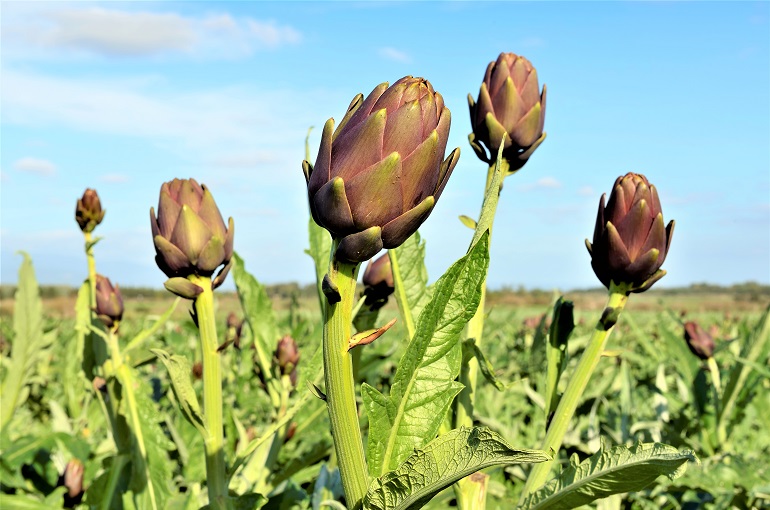Artichoke Fertilization Requirements

This post is also available in:
This post is also available in:
![]() Español (Spanish)
Español (Spanish) ![]() Français (French)
Français (French) ![]() Deutsch (German)
Deutsch (German) ![]() العربية (Arabic)
العربية (Arabic) ![]() Türkçe (Turkish)
Türkçe (Turkish) ![]() Ελληνικά (Greek)
Ελληνικά (Greek) ![]() Português (Portuguese (Brazil))
Português (Portuguese (Brazil))
Fertilization Programs in Artichoke Farming
Keep in mind that every field is different and no one can advise you on your crop fertilization program without knowing your field’s crop history and soil analysis. We will list some common fertilization programs used in artichoke farming, but you should not follow any of them without doing your own research.
Artichoke is a heavy feeder and requires a large amount of nitrogen to maximize the yield and quality of the heads while preserving the plants’ vigor. However, to cover the needs of the crop in nutrients sustainably and form an appropriate fertilization program, the farmer should start by performing a soil analysis and learn the crop history of the field. The fertilization can be performed with organic fertilizers (compost, manure, etc.) or synthetic complex chemical fertilizers applied directly to the soil or through fertigation (injection of water-soluble fertilizers into the irrigation system). Good results regarding the yield and dry matter of the heads were obtained when the typical fertilization regime was combined with biostimulant applications. However, it is highly recommended that you get the advice of a local licensed agronomist before applying any products.
The adequate soil levels for the three main nutrients are:
N → More than 20 ppm of Nitrate (in the top 30 cm of soil)
P → More than 60 ppm of Bicarbonate extractable phosphorus
K → More than 150 ppm of ammonium acetate-exchangeable potassium
Knowing the crop history of the field is necessary because there might be sufficient nutrients in the soil for the first growth stages of artichokes, thus decreasing the need for extra fertilization at that time. Generally, this is the case when planting artichokes after legumes cover crops that enrich the ground with nitrogen.
Depending on your field’s needs, you can start by incorporating 20-30 tons of well-rotted manure per hectare before planting. To cover the seasonal needs of the plants in organic cultivation, the grower can apply (side-dress) 1-2 lbs (or 0.5-1 kg) of composted chicken manure (or commercial organic fertilizers) right before the plants start to bud out.
In conventionally cultivated fields, the total amount of fertilizers are usually applied in 2 doses, one as a base dressing and one as a side dressing. If the farmer wants to use fertigation, he/she can start with the standard base fertilization and continue with applications through the irrigation system.
To maximize yields in perennial artichokes, farmers usually apply 112-224 kg of nitrogen (N) per hectare in the form of ammonium nitrate. The amounts are similar for fertigation with drippers (144-180 kg per hectare or 120-150 lb per acre). Multiple experiments had shown no further yield increase occurred when more than 280 kg of N per hectare (250 lb/acre) were used. As a result, we advise the farmers to avoid overfertilization with N. From the total N amount, one-fifth can be applied before planting. The needs of the plants reach a peak before bud formation, and that is the moment the farmer may have to apply at the soil the rest of the N fertilizer (60-100 lb per acre or 67-112 kg per hectare). If fertigation is used, the farmer should increase the weekly N dose from 6 kg per hectare in early stages to 12 kg per hectare (or 5.4 – 10 lb per acre) as the plants mature.
Most producers start to increase the soil nutrients by integrating 30-50 tons of well-rotted manure per hectare at 30-40 cm (12-16 in) depth prior the planting as basic fertilization, together with 500-600 kg/hectare (446-535 lb/acre) triple superphosphate (fertilizer 0-48-0) and 200-300 kg/hectare (178-268 lb/acre) of potassium sulfate (fertilizer 0-0-48). Phosphorus (P) and Potassium (K) can also be added and incorporated before planting with the base dressing every season. However, the potassium amounts needed per season can also be applied in 2 equal doses (with base and side dressing). In this case, potassium nitrate (13-0-46) fertilizers can be used. The total amounts per season for the two elements (P and K) are 100-120 kg/ha and 400 kg/ha, respectively (90-107 lb/acre and 357 lb/acre).
Approximately 15-25 lb of sulfur can be broadcasted and incorporated per acre (17-28 kg/ha) before planting. Furthermore, there also might be a need for foliar applications of calcium- and zinc-rich fertilizers in early spring.
Finally, some farmers use plant growth regulators like gibberellic acid to promote earliness (in perennials) and increase the uniformity of bud development. The regulator can be applied in 1-2 doses approximately six weeks before the expected first harvest. Other farmers apply it 5-7 weeks after transplanting. You shall avoid applications in large doses and with warm weather.
However, these are just common patterns that should not be followed without doing your own research. Every field is different and has different needs. Checking the soil condition and pH is vital before applying any fertilization method. You can consult your local licensed agronomist.
Check out Bulk Prices of Artichokes
References
https://www.nda.agric.za/docs/Brochures/Artichoke2011.pdf
https://horticulture.oregonstate.edu/oregon–vegetables/artichoke–globe
https://digitalcommons.usu.edu/cgi/viewcontent.cgi?article=1239&context=extension_curall
https://anrcatalog.ucanr.edu/pdf/7221.pdf
https://extension.usu.edu/yardandgarden/research/artichoke–in–the–garden
Negro, D., Montesano, V., Sonnante, G., Rubino, P., De Lisi, A., & Sarli, G. (2016). Fertilization strategies on cultivars of globe artichoke: Effects on yield and quality performance. Journal of plant nutrition, 39(2), 279-287.
Schrader, W. (1994). Growth regulator gives earlier harvest in artichokes. California agriculture, 48(3), 29-32.
How to Grow Artichokes at Home
How to Grow Artichokes for Profit – Professional Artichoke Farming
Climate and Soil Requirements for Artichoke Farming
Soil Preparation and Planting in Artichoke Farming
Artichoke Water Requirements and Irrigation Systems
Artichoke Fertilization Requirements
Artichoke Farming: Harvest, Yield, Storage, and Post-harvest handling








































































